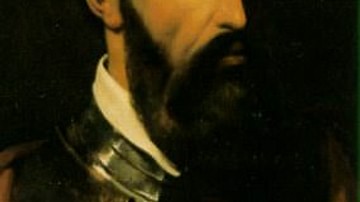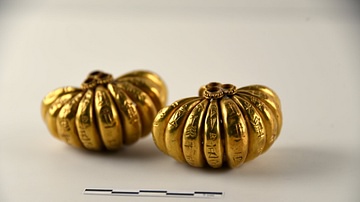Search
Search Results

Definition
Gold Beach
Gold Beach was the central of the five Allied D-Day Normandy landings of 6 June 1944. Primarily British units, with massive naval and air support, were set the task of taking the beach, a feat achieved by the end of the day, using a combination...

Video
Ancient Medicine, Healing and Physicians in Antiquity
Medicine in the ancient world was often combined with what we would consider magic, especially in Ancient Mesopotamia and Egypt. In Mesopotamia, the goddess Gula who is also known as Ninkarrak and Ninisinna presided over health and healing...

Video
Wine & Its Role in Classical Antiquity
A documentary on the history of wine in antiquity.

Video
The Ant-Men of Antiquity
Forget the comics, let's have a look at the real ancient history of the ant-men! The Myrmidons were loyal to Achilles and fought with such a strength that they were descended from both the ant and the gods. If you like our videos, please...

Video
Health Care and Epidemics in Antiquity: The Example of Ancient Mesopotamia
June 26, 2006 Walter Farber, Professor of Assyriology, University of Chicago From the "Epidemics Then & Now: Infectious Diseases Around the World," the 2006 University of Chicago Summer Institute for Educators. Co-sponsored by the Center...

Video
Scythians: the alternative lifestyle of antiquity
Curator St John Simpson explains how the nomadic Scythians may not have lived in cities, but they still had the skill and desire to live the good life. The BP exhibition Scythians: warriors of ancient Siberia 14 September 2017 – 14 January...

Article
The Gold Crowns of Silla
The Silla Kingdom ruled south-eastern Korea during the Three Kingdoms period (1st century BCE - 7th century CE) and then, as the Unified Silla Kingdom, all of Korea from 668 to 935 CE. The Silla produced fine pieces of art, but their most...

Article
Pizarro and Atahualpa: The Curse of the Lost Inca Gold
In November 1532 CE, Francisco Pizarro led a group of about 160 conquistadors into the Inca city of Cajamarca. The illiterate and illegitimate son of an Extremaduran nobleman and an impoverished woman, Pizarro had spent his entire life on...

Article
Cibola - The Seven Cities of Gold & Coronado
The Seven Cities of Cibola are the mythical lands of gold that the Spanish of the 16th century believed existed somewhere in the southwest of North America, comparable to the better-known mythical city of El Dorado. No sites matching the...

Article
A Gift from King Shulgi: A Pair of Gold Earrings
Gold is a treasure, and he who possesses it does all he wishes to in this world, and succeeds in helping souls into paradise. Christopher Columbus. On June 22, 2005, the Sulaymaniyah Museum of Iraqi Kurdistan purchased a pair of gold...